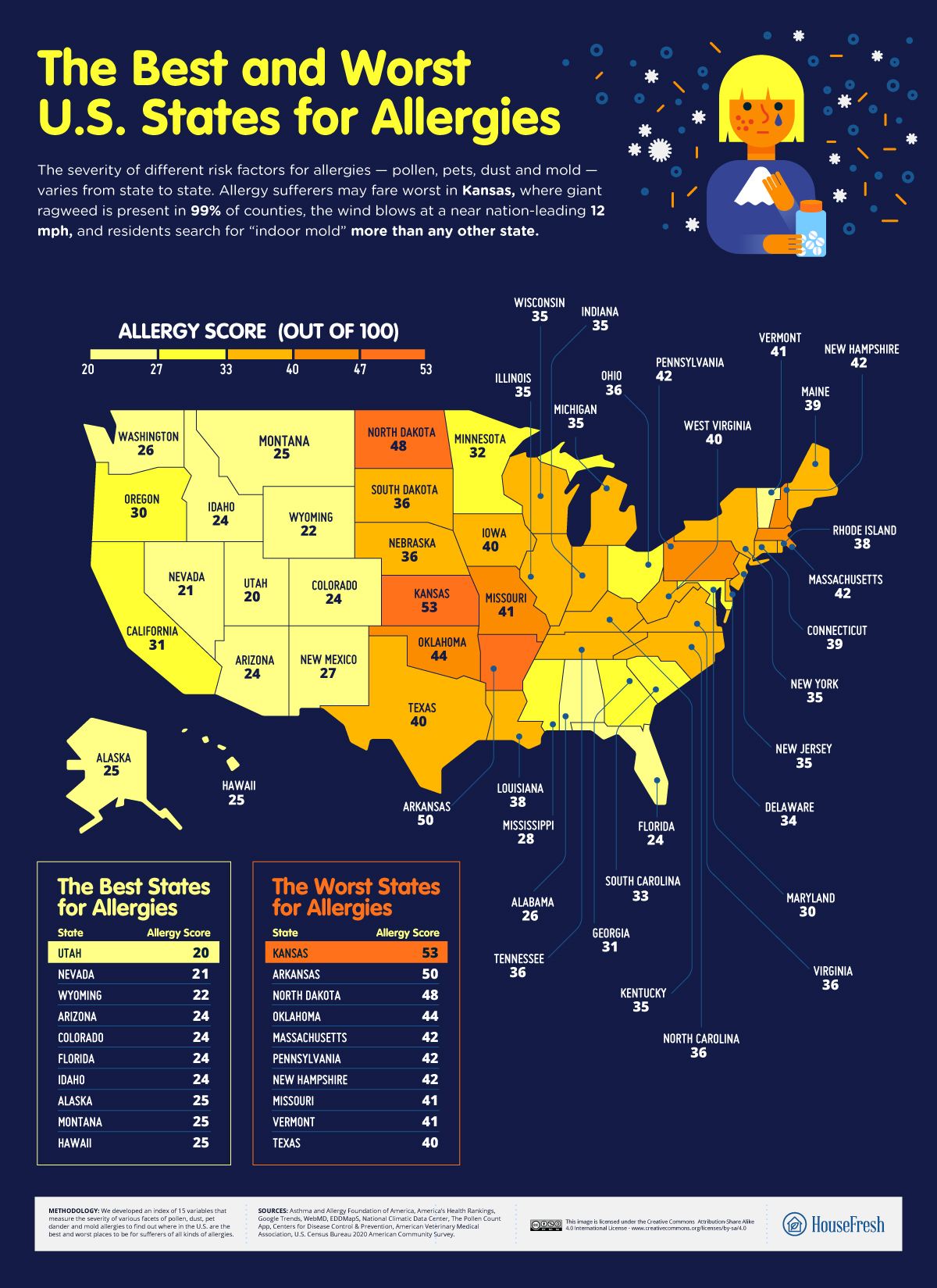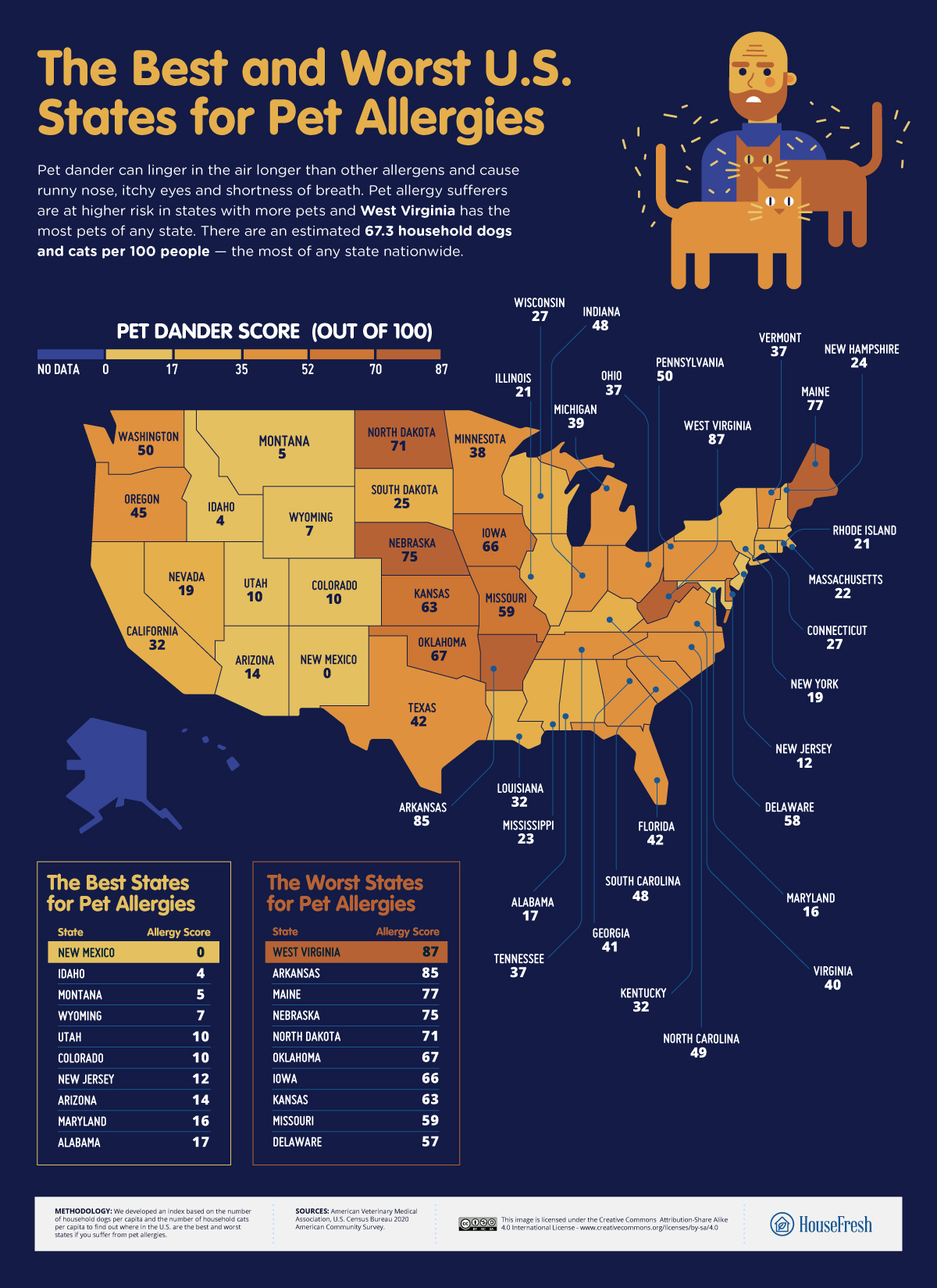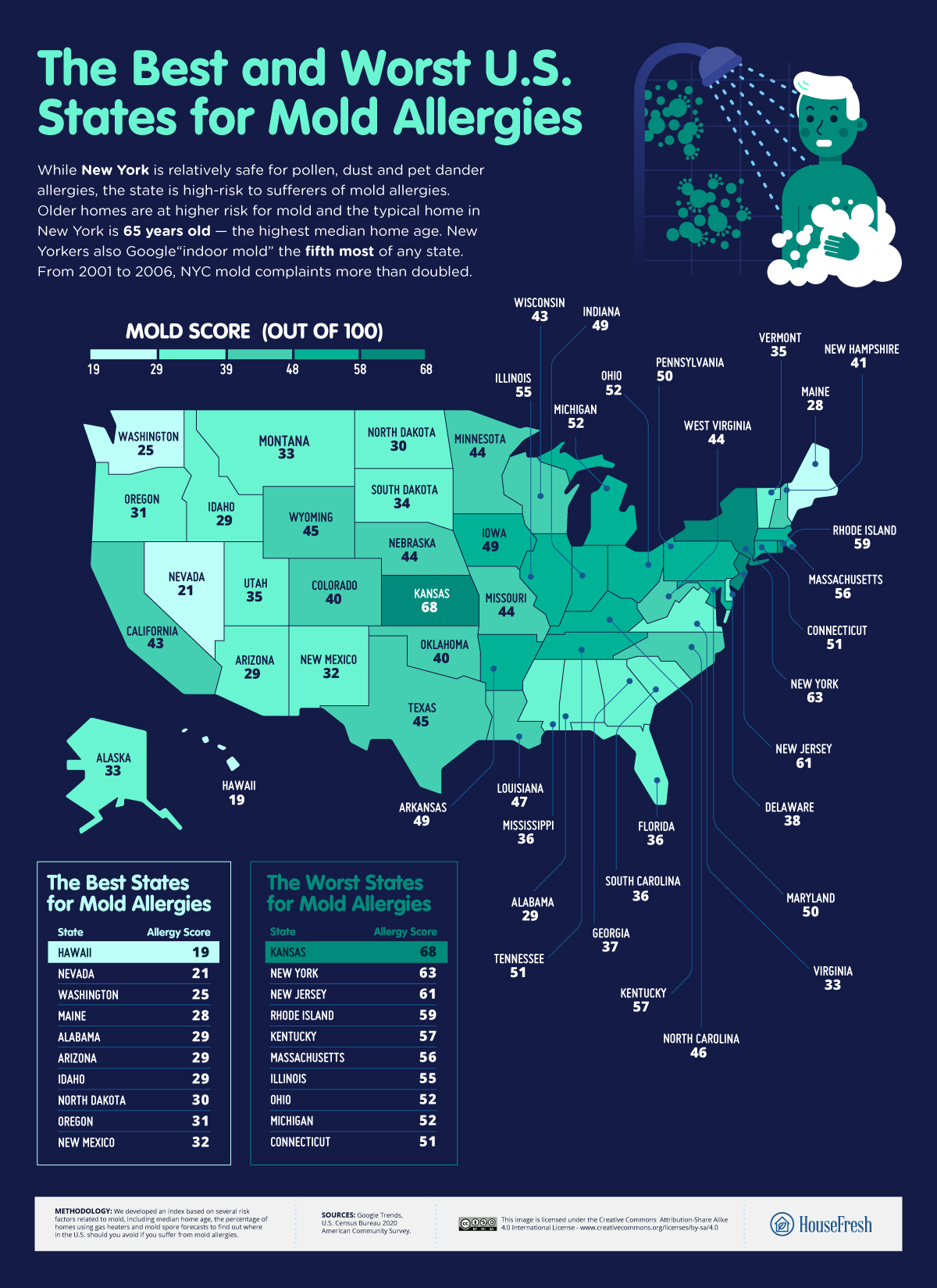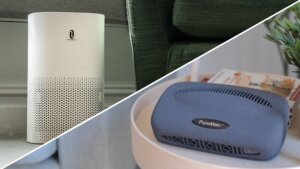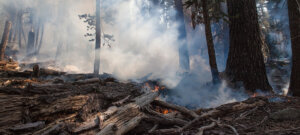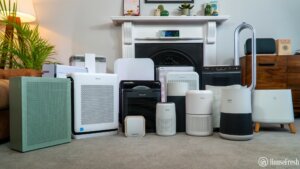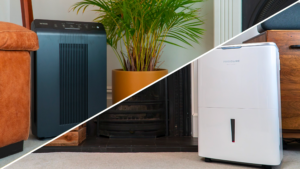Listen to this article:
According to the Centers for Disease Control and Prevention, more than 60 million Americans suffer from various types of allergies every year.
What are they? Allergies are reactions to invasive substances entering the body and exist in many forms. Airborne substances like pollen, mold spores, animal dander and dust can cause allergic reactions ranging from mild — itchiness, runny nose and watery eyes — to severe and even life-threatening.
The presence and severity of airborne allergies vary across the country and depend on local factors like climate, flora, fauna and construction materials. To see where airborne allergens are the most and least severe, we have determined the best and worst U.S. states for allergies.
To determine the best and worst U.S. states for allergies, HouseFresh developed an index of variables measuring the severity of various facets of pollen, dust, pet dander and mold allergies.
These factors include:
- The concentration of fine particle pollutants per cubic meter of air
- Google Trends searches for “Allergenic rhinitis due to pollen”
- City-level Allergy Capital rankings from the Asthma and Allergy Foundation of America
- Seasonal allergy symptoms report severity from WebMD
- The percentage of counties with logged instances of Ambrosia trifida (giant ragweed)
- Average wind speed from the U.S. Nuclear Regulatory Commission
- Grass and ragweed pollen forecasts
- The age-adjusted mortality rate of deaths due to dust-related causes
- Dogs and cats per capita from the American Veterinary Medical Association
- Google Trends searches for “Indoor mold”
- Median home age
- The percentage of homes using gas heating
- Mold spore count forecasts
Key findings
- Five of the ten worst states for allergies are in the South Central United States — Kansas, Arkansas, Oklahoma, Missouri and Texas.
- The five best states for allergy sufferers are all in the Rocky Mountain region of the Western United States — Utah, Nevada, Wyoming, Arizona and Colorado.
- The three best states for pollen allergies have the highest average elevation and relatively dry climates — Wyoming, Utah and Colorado.
- Vermont, Wisconsin and New Mexico have the most deaths per capita due to dust-related causes — while New Jersey, Oklahoma and Florida have the least.
- In West Virginia, there are 67.3 household dogs and cats per 100 people, the most of any state — in New Mexico, there are 18.5 household cats and dogs per 100 people, the least of any state.
- Google searches for “indoor mold” are the most common in Kansas — the worst state for mold allergies.
South Central U.S is an allergy hotspot
Five of the ten worst states for allergies are in the South Central United States: Kansas, Arkansas, Oklahoma, Missouri and Texas.
This south-central cluster ranks highly for its high pollen counts. According to symptom counts collected by WebMD, ragweed is present in a relatively large share of the region and all five states have moderately severe to severe allergy seasons. The South Central United States also has high wind speeds that can spread pollen in the air and exacerbate symptoms.
A list of the best states for allergies also reveals regional clustering. The five best states for allergy sufferers, for example — Utah, Nevada, Wyoming, Arizona and Colorado — are all in the Rocky Mountain region of the Western United States. Ragweed is present in a relatively small share of this area and the pollen allergy season is among the least severe of any region in the country.
Ragweed causes misery for pollen allergy sufferers
The three best states for pollen allergies — Wyoming, Utah and Colorado — have the highest average elevation and relatively dry climates.
The primary risk factor for those with pollen allergies is the presence of ragweed. Exposure to ragweed can also sensitize individuals to pollen allergy, inducing symptoms in those not genetically predisposed to ragweed allergies. While ragweed grows in virtually every part of the country — other than Alaska and most of Hawaii — the severity of ragweed pollen varies from state to state.
Pollinating plants need water to grow and spread. As a result, dry climates are often favorable to individuals with pollen allergies. Pollen counts are also usually lower at higher altitudes, where the most common ragweeds are less likely to flourish.
Dust is a major issue in Vermont, Wisconsin and New Mexico
According to the CDC, Vermont, Wisconsin and New Mexico have the most deaths per capita due to dust-related causes. In contrast, New Jersey, Oklahoma and Florida have the least.
According to the Asthma and Allergy Foundation of America, an estimated 20 million Americans have dust mite allergies. Dust mites are microscopic, insect-like pests that produce waste products that can cause mild symptoms like runny nose and watery eyes — or severe symptoms like persistent cough and congestion — in those with dust allergies.
Dust mites occur naturally and are often found in bedding, mattresses, carpets and curtains within the home. According to the American Lung Association, dust mites likely exist in at least one bed in 80% of homes in the United States. Dust mites need moisture to survive and thrive in humid environments.
Most exposure to dust mites occurs in the home, but some of the most dangerous exposure to dust occurs in the workplace. Occupational exposure to high concentrations of dust is directly linked to the development of severe respiratory problems and, sometimes, fatal illnesses. And while most industries have air quality regulations to prevent workers, thousands of U.S. workers die annually due to dust-related causes.
More pets in West Virginia means more allergies
In West Virginia, there are 67.3 household dogs and cats per 100 people, the most of any state. Meanwhile, in New Mexico, there are 18.5 household cats and dogs per 100 people, the least of any state.
Pets with fur shed microscopic dead skin flakes, which can linger in the air and cause symptoms like stuffy nose, itchy eyes and shortness of breath in those with pet allergies. According to the Asthma and Allergy Foundation of America, cat and dog allergies affect 10% to 20% of the world’s population.
Pet allergies are likely to become more prevalent as pet ownership increases. Exposure to pets has also been proven to increase sensitivity to animal allergens in those without pre-existing pet allergies.
While the best way to prevent pet allergy triggers is to avoid exposure to pet dander, an estimated 70% of U.S. households own a pet. The prevalence of pets varies heavily from state to state, with the number of cats and dogs per capita more than three times higher in the states where pets are most common than in the states where pets are least common.
People in Kansas are preoccupied with mold allergies
Google searches for “indoor mold” are the most common in Kansas, the worst state for mold allergies.
Molds reproduce through spores that can linger in the air like pollen and cause allergic reactions in those with mold allergies. Symptoms of mold allergies can include nasal congestion, sore throat, sneezing, dry cough, shortness of breath and skin irritation.
Outdoor mold can grow under fallen leaves or in rotting vegetation, while indoor mold often grows in basements, attics, cabinets beneath the sink, damp moldings and washing machines. While the exact incidence of mold allergies is unknown, estimates of mold allergy prevalence range from 3% to 10% of the general population, according to a 2015 paper published in the Allergy, Asthma & Immunology Research journal.
Mold grows in damp, dark places and flourishes in humid, moist climates. Other risk factors for indoor mold growth include old homes and gas heaters. In New York, the typical home is 65 years old — the oldest median home age of any state and 21 years older than the U.S. median.
Some 63.7% of homes use gas heaters, greater than the 52.4% national figure. These may be two reasons why Google searches for “indoor mold” are more common in New York than all but four other states and why New York is one of the worst for mold allergies.
How to reduce your exposure to allergy triggers
Different allergies can cause a range of symptoms, including nasal congestion, watery eyes, coughing and breathing difficulties. If you consistently show symptoms of an allergy, it’s best to speak with a doctor. Although identifying the root cause can be complicated and often invasive, your GP may be able to help provide a diagnosis.
You can reduce your exposure to the different things that trigger your specific symptoms with the help of the following tips:
- Try to stay indoors when it’s a dry and windy spring day – especially if it’s early in the morning.
- Avoid going outside when someone is mowing the lawn or trimming hedges and trees outside.
- If you have to go outside, wear a face mask. Also, take off your clothes and shower when you come back.
- Don’t hang laundry outside to avoid bringing pollen back indoors.
- Close doors and windows when high pollen counts are forecasted.
- Hoover carpets, upholstered furniture and curtains regularly with a HEPA filtered vacuum cleaner to catch as much as 99% of dust and debris.
- Avoid using a dry cloth or feather duster — opt for a microfiber cloth or a damp rag instead as it will help trap most dust without recirculating it into the air.
- To prevent dust from blowing in from the outdoors, simply apply caulk to gaps around windows and be sure to replace worn weatherstripping around doors.
- Hot wash your bedding once a week and once dry, give it 10 minutes on high heat in a tumble dryer to eliminate dust mites.
- Use a soft cloth to clean home surfaces and a HEPA filtered vacuum on carpets twice per week at a minimum.
- If possible, consider replacing your carpet with a hardwood or linoleum floor to reduce pet dander buildup.
- Regularly brush your pet to reduce the dander in their fur before it is released into the air.
- Try to create pet-free zones around your home (even if just your bedroom!) so you can reduce your contact hours with dander.
- Invest in an air purifier with a high quality HEPA filter that can remove pet dander particles from the air.
- Keep your home dry by fixing leaks, venting your clothes dryer to the outside, and using insulation and storm windows.
- Consider installing exhaust fans in your bathroom and kitchen, and a ceiling fan in the basement to improve ventilation throughout your home.
- Make sure existing fans do not vent into the attic, but vent outside your home instead.
- Scrub your carpet(s) if you spot any visible mold spores. Here’s a step-by-step guide on how to get mold out of a carpet.
- Considering getting a dehumidifier for your bathroom to help remove moisture from the air.
If you can only do one thing, then consider getting yourself an air purifier with a good HEPA filter to help tackle different airborne allergens, including microscopic dust particles, chemical irritants, mold spores, pet dander particles, and many other pollutants that could trigger allergies.
Check out our list of the best air purifiers for allergies, based on over 50 air purifier performance tests.
Final thoughts
If you feel like your allergies have gotten worse in recent years, you are not alone. Due to several factors associated with human-caused climate change, global temperatures and carbon dioxide levels are rising — causing more pollen production and effectively lengthening the pollen season.
According to one study published in 2021 in the Proceedings of the National Academy of Sciences, pollen seasons start 20 days earlier than in 1990, areten0 days longer and feature 21% more pollen. Climate change has also been linked to increased mold and dust concentrations. Pet ownership is also growing, meaning more sneeze-inducing pet dander.
According to a 2021 survey conducted by healthcare company SingleCare, 82% of individuals with allergies believe that allergies affect their quality of life to some degree. Allergies can interfere with daily tasks and cause significant discomfort during the dreaded spring and fall months.
But while allergies can limit individuals from certain activities, knowing where different allergens are the most and least prevalent can help those suffering navigate travel and avoid triggering the worst of their symptoms. So, before you take your next trip, do you know the best and worst U.S. states for allergies?
SOURCES
- American Veterinary Medical Foundation. (2022). American Veterinary Medical Association. amva.org
- Asthma and Allergy Foundation of America. (2022). AAFA 2022 Allergy Capitals Report March 2022. aafa.org
- BreezoMetter.com. (2022). Pollen Count API. breezometer.com
- Centers for Disease Control and Prevention. (2022).Centers for Disease Control and Prevention. cdc.gov
- Google. (2022). Google Trends. google.com
- The U.S. Nuclear Regulatory Commission. (2022). Average Wind Speeds. nrc.gov
- United Health Foundation. (2022). Air Pollution. americashealthrankings.org
- United States Census Bureau. (2022). Median Home Age. census.gov
- United States Census Bureau. (2022). Percentage of Homes Using Gas Heating. census.gov
- University of Georgia. (2022). Giant Ragweed (Ambrosia trifida). eddmaps.org
- WebMD. (2022).WebMD: Seasonal Allergy Symptoms Nationwide. webmd.com


